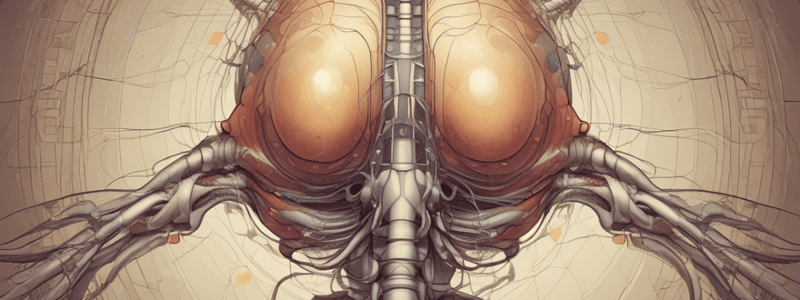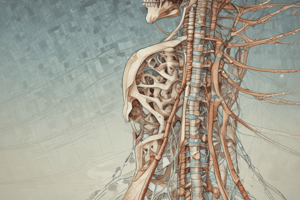Podcast
Questions and Answers
Which type of reflex is responsible for maintaining posture?
Which type of reflex is responsible for maintaining posture?
- Golgi Tendon
- Stretch (correct)
- Crossed extensor
- Flexor/Withdrawal
What is the primary function of the Golgi Tendon Reflex?
What is the primary function of the Golgi Tendon Reflex?
- To sense changes in muscle tension (correct)
- To sense changes in joint position
- To sense changes in proprioception
- To sense changes in muscle length
What is the pathway that upper motor neurons take to reach the spinal cord?
What is the pathway that upper motor neurons take to reach the spinal cord?
- Dorsal column
- Spinothalamic tract
- Ventral horn
- Corticospinal tract (correct)
What type of information is carried in the dorsal columns?
What type of information is carried in the dorsal columns?
What is the purpose of the reciprocal innervation process?
What is the purpose of the reciprocal innervation process?
What is the clinical significance of testing reflexes?
What is the clinical significance of testing reflexes?
What is the name of the tract that carries information related to pain, temperature, and vague touch?
What is the name of the tract that carries information related to pain, temperature, and vague touch?
What is the function of the ascending tracts in the spinal cord?
What is the function of the ascending tracts in the spinal cord?
What is the term for the organization of the spinal cord into specific segments that correspond to specific regions of the body?
What is the term for the organization of the spinal cord into specific segments that correspond to specific regions of the body?
What is the neurotransmitter used by lower motor neurons at the neuromuscular junction?
What is the neurotransmitter used by lower motor neurons at the neuromuscular junction?
What is the primary function of the dorsal horn in the spinal cord?
What is the primary function of the dorsal horn in the spinal cord?
What is the term for the nerve fibers that project from the end of the spinal cord?
What is the term for the nerve fibers that project from the end of the spinal cord?
How many pairs of spinal nerves are there in total?
How many pairs of spinal nerves are there in total?
What is the main difference in organization between the spinal cord and the brain?
What is the main difference in organization between the spinal cord and the brain?
What is the term for the lower border of L1, where the spinal cord ends in adults?
What is the term for the lower border of L1, where the spinal cord ends in adults?
Which of the following is NOT a function of the ventral horn in the spinal cord?
Which of the following is NOT a function of the ventral horn in the spinal cord?
What is the primary cause of spinal shock?
What is the primary cause of spinal shock?
Which of the following is a characteristic of neurogenic shock?
Which of the following is a characteristic of neurogenic shock?
What is the primary mechanism of hypothermia in neurogenic shock?
What is the primary mechanism of hypothermia in neurogenic shock?
Autonomic dysreflexia is characterized by which of the following?
Autonomic dysreflexia is characterized by which of the following?
What is the primary mechanism of autonomic dysreflexia?
What is the primary mechanism of autonomic dysreflexia?
Which of the following is NOT a clinical manifestation of autonomic dysreflexia?
Which of the following is NOT a clinical manifestation of autonomic dysreflexia?
What is the first step in treating autonomic dysreflexia?
What is the first step in treating autonomic dysreflexia?
Which level of spinal cord injury is associated with the greatest risk of autonomic dysreflexia?
Which level of spinal cord injury is associated with the greatest risk of autonomic dysreflexia?
What is the most common cause of Central Cord Syndrome?
What is the most common cause of Central Cord Syndrome?
In Central Cord Syndrome, why are sacral nerve fibers almost always spared?
In Central Cord Syndrome, why are sacral nerve fibers almost always spared?
What type of sensations would be preserved in a patient with Anterior Cord Syndrome?
What type of sensations would be preserved in a patient with Anterior Cord Syndrome?
What is the characteristic sensory loss pattern in Brown-Sequard Syndrome?
What is the characteristic sensory loss pattern in Brown-Sequard Syndrome?
What is the primary cause of Subacute Combined Degeneration?
What is the primary cause of Subacute Combined Degeneration?
What is the primary function of Vitamin B12 in the context of Subacute Combined Degeneration?
What is the primary function of Vitamin B12 in the context of Subacute Combined Degeneration?
What is the primary difference between Spinal Shock and Neurogenic Shock?
What is the primary difference between Spinal Shock and Neurogenic Shock?
What is the primary treatment for Subacute Combined Degeneration?
What is the primary treatment for Subacute Combined Degeneration?
Which of the following tracts carries messages related to touch, vibration, and proprioception?
Which of the following tracts carries messages related to touch, vibration, and proprioception?
What type of spinal cord injury is characterized by a transient dysfunction of the spinal cord with or without vertebral damage and no pathologic changes?
What type of spinal cord injury is characterized by a transient dysfunction of the spinal cord with or without vertebral damage and no pathologic changes?
Which of the following is a result of the secondary cord injury cascade?
Which of the following is a result of the secondary cord injury cascade?
What is the primary site of entry for the spinothalamic tract in the spinal cord?
What is the primary site of entry for the spinothalamic tract in the spinal cord?
Which of the following types of spinal cord injury is most likely to cause a complete loss of motor and sensory function below the level of injury?
Which of the following types of spinal cord injury is most likely to cause a complete loss of motor and sensory function below the level of injury?
What is the primary mechanism of neuronal injury in excitotoxicity?
What is the primary mechanism of neuronal injury in excitotoxicity?
Which of the following tracts is most likely to be damaged in a patient with motor and proprioception deficits on the left side?
Which of the following tracts is most likely to be damaged in a patient with motor and proprioception deficits on the left side?
What is the most common location for spinal cord injuries?
What is the most common location for spinal cord injuries?
Which of the following is a characteristic of incomplete spinal cord injuries?
Which of the following is a characteristic of incomplete spinal cord injuries?
What is the primary cause of infarction in spinal cord injuries?
What is the primary cause of infarction in spinal cord injuries?
Flashcards are hidden until you start studying
Study Notes
The Spinal Cord
- Lies within the vertebral column, covered by the meninges, and originates in the medulla oblongata
- Carries two types of information:
- Efferent motor neuron outputs from the brain
- Afferent sensory neural inputs to the brain from the body
- In the adult, the spinal cord extends to the lower border of L1
- Conus medullaris: ~L1/L2, end of the spinal cord
- Cauda Equina: nerve fibers projecting from end of spinal cord > S5
- 31 pairs of spinal nerves, all containing both efferent motor and afferent sensory fibers
Gray Matter Horns
- Dorsal Horn: axons/interneurons of sensory (afferent) neurons (cell bodies live in dorsal root ganglion)
- Ventral Horn: cell bodies for motor (efferent) pathways leaving spinal cord
Spinal Cord Organization
- Superficial white matter tracts surround deeper gray matter
- Somatotopic organization within central gray matter and surrounding white matter tracts
Upper and Lower Motor Neurons
- Upper Motor Neurons:
- Cell bodies live in motor cortex of the brain with axons reaching down to a certain vertebral level in corticospinal tract
- Crosses from one side of the body to the other at the level of the brain stem
- Uses glutamate as neurotransmitter
- Lower Motor Neurons:
- Cell bodies live in ventral horn of the spinal cord with axons reaching out into PNS
- Uses acetylcholine as neurotransmitter at neuromuscular junction
Spinal Reflexes
- Definition: involuntary, near-instant response to a stimulus that does not involve input from the brain
- Types of reflex arcs:
- Autonomic – visceral organs
- Somatic
- Stretch – plays a major role in maintaining posture
- Golgi Tendon Reflex – senses if there is too much muscle tension
- Crossed extensor – helps body compensate for a stimulus on one side of the body
- Flexor/Withdrawal – withdrawal in response to noxious stimulus
Reflex Arc
- Stretch Reflex Arc:
- Four processes: monosynaptic response, reciprocal innervation, synergistic muscle recruitment, ascending information
Clinical Correlation
- Stretch Reflex operates as a protective mechanism to prevent strain/tear of muscles and tendons
- Clinically, we can get information about the spinal cord, peripheral nerves, and muscle tone/strength by checking reflexes
Spinal Cord Organization
- Dermatomes & Myotomes:
- Sensory: dermatomes
- Motor: myotomes
- Ascending and Descending Tracts:
- In the spinal cord, certain types of information are carried within specific tracts that are physically separated
- By knowing which type of info lives in which tract, we can understand the type and degree of injury based on clinical exam
Afferent Pathways (Ascending)
- Spinothalamic:
- Vague touch
- Pain (nociception)
- Temperature
- Fibers decussate (cross over) immediately at their level of entry into spinal cord
- Dorsal Columns:
- Basic (normal) perception of touch
- Proprioception
- Vibration
- Fibers cross at the medulla
Efferent Pathways (Descending)
- Corticospinal Tracts:
- Efferent/motor control below the head
- Contain upper motor neurons
- Some fibers stay ipsilateral and travel in the anterior corticospinal tract
- Mostly innervate very proximal muscles in extremities
Spinal Cord Injuries
- Complete vs Incomplete Spinal Cord Injury:
- Complete spinal cord transection: will interrupt all three tracts with complete loss of motor/sensory function below the level of injury
- Incomplete spinal cord injury: variable degree of dysfunction due to only part of the spinal cord being affected
Types of Spinal Cord Injury
- Cord concussion
- Cord contusion
- Cord compression
- Transection
- Hemorrhage
- Infarct/Obstruction of blood supply
- Can be "complete" or "incomplete"
Evolution of Spinal Cord Injury
- Primary cord injury: the actual trauma/compression/transaction etc itself
- Secondary cord injury: cascade of events leading to swelling and tissue destruction
- Resolution of symptoms: weeks, months, maybe never
Studying That Suits You
Use AI to generate personalized quizzes and flashcards to suit your learning preferences.




